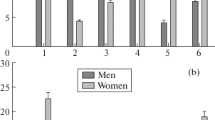Objective. To run complex investigations of patients with chronic reflex syndrome (CRS). Materials and methods. A total of 136 patients (70 women and 66 men) with chronic reflex syndrome were investigated. Pain was assessed on a visual analog scale (VAS) and levels of natural antibodies (n-Ab) to opioid peptides (β-endorphin and orphanin) and biogenic amines (dopamine and serotonin) were determined; surface electromyograms (sEMG) of the erector spinae muscle were recorded at the L3–L4 level on both sides. Parameters were measured at the beginning (day 1), in the middle (day 10), and end (day 21) of treatment. Results. Significant reductions in pain intensity (by 63% in women and 71% in men) were accompanied by 10–25% decreases in muscle tension in terms of group sEMG amplitude and by 34–38% in terms of individual dynamics of sEMG amplitude. Levels of n-Ab to all endogenous pain regulators were initially mostly elevated or high. Changes in n-Ab levels were in different directions. By the end of treatment (day 21), there were increases in the frequency of high levels of n-Ab to opioid peptides (39–41% of women and 33–39% of men) and normal levels of n-Ab to serotonin (in 52% of women and 59% of men). Levels of n-Ab to dopamine in women on day 21 were mainly normal (56% of subjects), while in men they were mostly elevated (in 50%) or high (in 17%). Conclusions. Changes in immunological measures did not correlate with pain intensity and evidently reflected pathological changes in neurohumoral interactions in chronic pain. Thus, monitoring of individual endogenous pain regulator n-Ab profiles in patients may have predictive value in assessing the further process of chronicization of pain status.
Similar content being viewed by others
References
C. Johannes, T. Le, X. Zhou, et al., “The prevalence of chronic pain in United States adults: results of an Internet-based survey,” J. Pain, 11, No. 11, 1230–1239 (2010), https://doi.org/https://doi.org/10.1016/j.jpain.2010.07.002.
N. Attal, D. Bouhassira, and R. Baron, “Diagnosis and assessment of neuropathic pain through questionnaires,” Lancet Neurol., 17, No. 5, 456–466 (2018), https://doi.org/https://doi.org/10.1016/S1474-4422(18)30071-1.
S. S. Pavlenko, Lower Back Pain (epidemiology, clinical and diagnostic classification, current directions in diagnosis, treatment, and standardization of medical care). Guidelines, Sibmedizdat, NGMU, Novosibirsk (2007).
E. V. Podchufarova, “Back pain: mechanisms of development and treatment,” Sovrem. Ter. Psikhiatrii Nevrol., No. 3, 47–54 (2012).
E. V. Podchufarova, “Current questions in acute and chronic pain in the lumbosacral area,” Nevrol. Neiropsikh. Psikhosom., 4, No. 1, 27–35 (2012), https://doi.org/https://doi.org/10.14412/2074-2711-2012-358
E. V. Podchufarova and D. V. Razumov, “Myogenic backpain: clinical features, mechanisms of formation, and treatment,” Ross. Zh. Boli, No. 3–4, 46–54 (2011).
V. G. Ovsyannikov, A. E. Boichenko, V. V. Alekseev, et al., ”The antinociceptive system,” Med. Vestn. Yuga Ross., No. 3, 46–54 (2014).
M. E. Geisser, “Surface electromyography and low back pain,” Biofeedback, 35, No. 1, 13–16 (2007).
R. Neblett, “Surface electromyographic (SEMG) biofeedback for chronic low back pain,” Healthcare (Basel), 4, No. 2, 27 (2016), https://doi.org/https://doi.org/10.3390/healthcare4020027.
L. V. Semashko, “Effectiveness of use of a system of body adaptations to high psychoemotional and physical loads in students (PPA system),” Asimmetriya, 3, No. 2, 51–66 (2009).
Yu. R. Zaripova and A. Yu. Meigal, “Comparative electromyographic analysis of neuromuscular status in neonates of different gestational ages,” Kazan. Med. Zh., 92, No. 6, 816–820 (2011).
T. I. Dolganova, D. V. Dolganov, and S. O. Ryabykh, “Diagnostic information value of the EMG envelope of the superficial paravertebral muscles in postural stereotypes in patients with grade III and IV scoliosis,” Gen. Ortoped., 24, No. 1, 57–63 (2018), https://doi.org/https://doi.org/10.18019/1028-4427-2018-24-1-57-63.
B. Gerdle, B. Ghafouri, M. Ernberg, and B. Larsson, “Chronic musculoskeletal pain: review of mechanisms and biochemical biomarkers as assessed by the microdialysis technique,” J. Pain Res., 7, 313–326 (2014), https://doi.org/https://doi.org/10.2147/JPR.S59144.
L. Toll, M. R. Bruchas, Calo’ G, et al., “Nociceptin/orphanin FQ receptor structure, signaling, ligands, functions, and interactions with opioid systems,” Pharmacol. Rev., 68, No. 2, 419–457 (2016), https://doi.org/https://doi.org/10.1124/pr.114.009209.
Yu. V. Karakulova, “Serotoninergic mechanisms of chronic tension headache,” Ross. Zh. Boli, 52, No. 1, 9–10 (2017).
S. I. Igon’kina, L. A. Vetrilé, and M. L. Kukushkin, “Effects of antibodies to noradrenaline on the development of neuropathic pain,” Bull. Exp. Biol. Med., 162, No. 12, 678–681 (2016), https://doi.org/https://doi.org/10.1007/s10517-017-3695-0.
S. I. Igon’kina, L. A. Vetrilé, T. V. Davydova, and V. G. Fomina, “Pronociceptive and antinociceptive effects of anti-serotonin antibodies,” Ross. Zh. Boli, 42, No. 1, 14–15 (2014).
A. I. Levashova, V. S. Morozova, O. Yu. Polyvyanaya, et al., “Comparative analysis of pain syndrome intensity and immunochemical parameters – the level of natural antibodies in patients with chronic dorsalgia,” Biol. Membr., 31, No. 3, 218–225 (2014), https://doi.org/https://doi.org/10.7868/S0233475514030050.
I. A. Zakharova, L. A. Vetrilé, and V. V. Shvets, “Chronic pain syndrome in vertebral osteochondrosis: autoantibodies to neurotransmitters,” Ross. Zh. Boli, 46, No. 1, 65–66 (2015).
V. K. Reshetnyak, “Gender differences in cortical-subcortical brain structures involved in pain perception,” Ross. Zh. Boli, 42, No. 1, 20–21 (2014).
A. E. Umryukhin, “Antibodies in the mechanisms of autonomic and behavioral functions of the body,” Fundament. Issled., No. 3–2, 425–430 (2013).
E. G. Borisova and V. V. Nikitenko, “Studies of catecholamines in chronic pain syndromes of the oral cavity,” Ross. Zh. Boli, No. 2, 8–9 (2016).
A. V. Kuchaeva, “Biopsychosocial analysis of the pharmacotherapy of chronic pain syndrome in depression,” Biotekhnol. Med., No. 8, 7–9 (2013).
A. E. Barulin, O. V. Kurushina, B. M. Kalinchenko, and E. P. Chernovolenko, “Chronic pain and depression,” Lekarstv. Vestn., 10, No. 1, 3–10 (2016).
L. Coppeta, S. Gentili, S. Mugnaini, et al., “Neuromuscular functional assessment in low back pain by surface electromyography (SEMG),” Open Public Health J., 12, 61–67 (2019), https://doi.org/https://doi.org/10.2174/1874944501912010061.
Author information
Authors and Affiliations
Corresponding author
Additional information
Translated from Zhurnal Nevrologii i Psikhiatrii imeni S. S. Korsakova, Vol. 120, No. 12, Iss. 1, pp. 73–79, December, 2020.
Rights and permissions
About this article
Cite this article
Levashova, A.I., Myagkova, M.A. & Moseikin, I.A. Immunochemical and Electromyographic Indicators for Assessment of Pain Status in Reflex Syndrome. Neurosci Behav Physi 51, 1066–1072 (2021). https://doi.org/10.1007/s11055-021-01166-3
Received:
Accepted:
Published:
Issue Date:
DOI: https://doi.org/10.1007/s11055-021-01166-3




